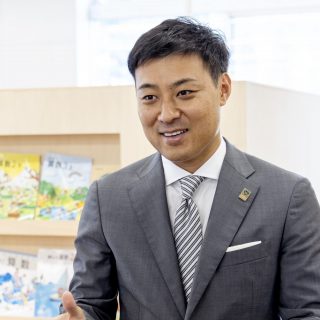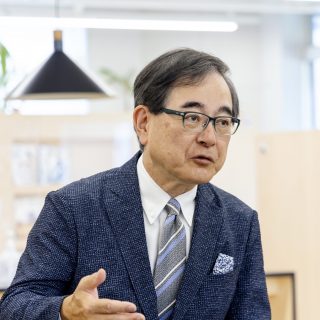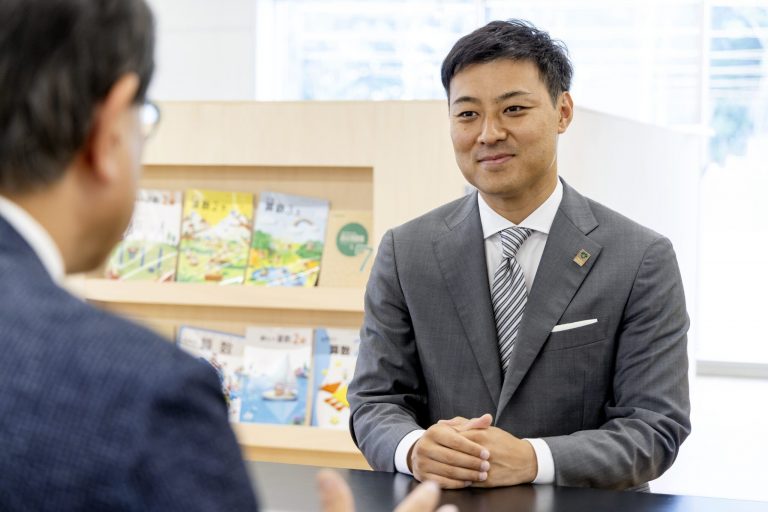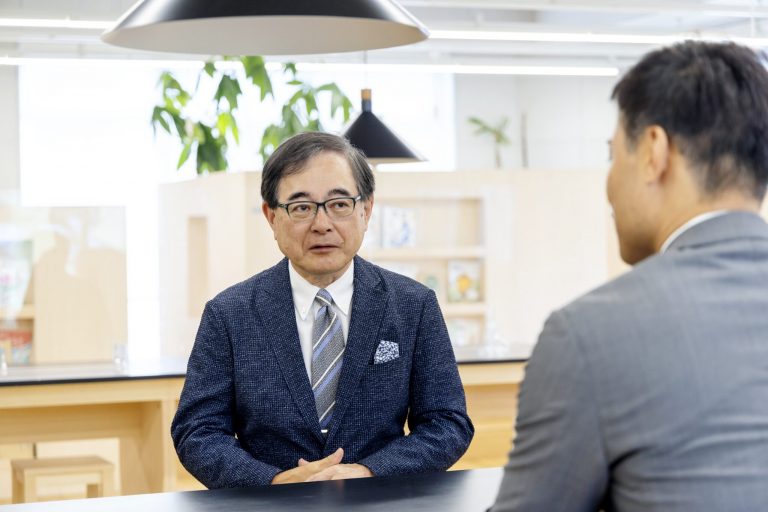Realizing children’s dreams and growing together with them, with the slogan “Nice Try!”
This article was published in the Autumn 2023 issue of Litterae Populi.

Kensuke Tanaka fascinated fans as he kept running across the baseball field as a NBP and MLB player for some 20 years. He is currently nurturing the hearts of nursery school, kindergarten, and elementary school children as the chairman of Tanaka Gakuen and Tanaka Gakuen Welfare Association.
President Kiyohiro Houkin, who is promoting reform to realize an unprecedented university, interviewed Mr. Tanaka about his life and career change, and how his passion for education will expand future possibilities.
Kensuke Tanaka (Guest)

Born in Fukuoka Prefecture in 1981. Joined Nippon-Ham Fighters from Higashi Fukuoka High School as the second round draft pick in 1999. Became a regular player in 2006, and contributed to the team’s five league and two national championships. Signed a contract with San Francisco Giants in the US in 2013 and was called up to MLB in July that year. Returned to the Nippon-Ham Fighters in 2015 after playing in the US and retired in 2019. Played in 1,634 games in total in Japan and the US, received the Best Nine Award (best second baseman) six times and the Golden Glove Award five times. Became the chairman of Tanaka Gakuen in 2020. Opened Tanaka Gakuen Ritsumeikan Keisho Elementary School in April 2022.
Kiyohiro Houkin (Interviewer)

Born in Hokkaido in 1954. Graduated from Hokkaido University School of Medicine. Doctor (medicine) (Hokkaido University). Worked for Hokkaido University Hospital and other facilities since 1979. After working as a visiting researcher at the University of California, Davis, became an assistant professor at the Hokkaido University Graduate School of Medicine in 2000, professor of Sapporo Medical University School of Medicine in 2001 and professor of the Hokkaido University Graduate School of Medicine in 2010. After becoming the director of Hokkaido University Hospital and vice executive president of Hokkaido University in 2013, and the director of Hokkaido University Hospital and vice president of Hokkaido University in 2017, assumed the present position in October 2020.
Days of practice and effort to realize his dream of becoming a baseball player
Houkin: I suppose you are not only busy as the chairman of Tanaka Gakuen, but also in many other ways.
Tanaka: I put full effort in everything, that is, 70% in my work as the chairman, 20% in the training of Nippon-Ham Fighters team players and the rest in my work as a professional baseball commentator.
Houkin: I understand you are from Chikushino, Fukuoka. How did you get involved in baseball?
Tanaka: I began to play baseball when I was in the second grade of elementary school under the influence of my older brother who was playing baseball. I played baseball almost every day, and continued to do so after I became professional. So I didn’t have much experience going somewhere on my days off (laugh).
Houkin: You were in Higashifukuoka High School, which was known to be strong in sports.
Tanaka: I went to the Koshien high school baseball tournament three times—spring and summer of my second year and summer of my third year.

The manager at the time asked me what I wanted to become in the future, and as my answer was a professional baseball player, he set goals to make my dream come true. Although those days were very hard, I managed to get through them thanks to his guidance toward my goal.
Houkin: You were drafted to join Nippon-Ham Fighters and started your career as a professional baseball player in 1999. I was surprised that it took more than six years until you became a regular player. Didn’t you consider following a different path during those years?
Tanaka: As the career of an average professional baseball player is around 7 years, I had almost run out of time when I became a regular player in my seventh year. I think I worked my way up very slowly. However, I believed that I would have a chance, especially with batting, and that all I had to do was to improve my fielding.
Houkin: When you became a regular player, the Fighters seemed to be especially strong.
Tanaka: I became a regular in 2006, when the Hokkaido Nippon-Ham Fighters became the national champion for the first time. The ten or so years after that were really the golden age for me. I’m the only player who has experienced five league- and two national championships.
Houkin: Could you tell me how you practiced and what you did from a mental perspective to maintain a regular position in professional baseball?
Tanaka: Baseball is basically a cat-and-mouse game. You have to get ahead of the opponent, or you’ll lose. I tried to predict the future and act boldly. That’s why I dared to make drastic changes when I was getting results.
Especially during games, there are many things that have to be predicted. When batting, some are good at guessing if the pitch will be a fastball or a breaking ball. I was probably good at that.
A new challenge—choice to be a major league player
Houkin: Why did you want to be a major leaguer? I think you had various options at the time and you were at a fork in the road of your life.
Tanaka: I wanted to keep taking on new challenges, probably because of my nature. I also easily get bored (laugh). I knew that I should be able to keep a regular position, but sometimes I felt it wasn’t enough …
At the same time, I thought I should stay with the Fighters considering my future and for a living. It caused me much distress. Nevertheless, my wish to go to the States was stronger, and I decided to sign a minor league contract. Even though I had to dip into my savings for a living, I had a strong desire to play in the States.
Houkin: You must have gained a lot by becoming a major leaguer.
Tanaka: Actually, I experienced many more hardships. Life has its ups and downs. If you dare to jump down when things are looking up, you may actually be able to take advantage of the situation.
In that sense, I think making the big decision to try to be a major leaguer was good for me, after all.
Houkin: I think it is a very important point. As far as Hokkaido University is concerned, “Boys, be ambitious” was not just a verbal message of Dr. Clark. Since it meant life to him, people could feel with him and followed him. Your school’s educational philosophy and the three Cs representing its children—challenge, collaboration and contribution—must have been greatly affected by your experience in the States.

Feelings for Hokkaido and second career decision
Houkin: Were you strongly considering returning to the Fighters when you returned from the States? Did your feelings for Hokkaido affect your decision?
Tanaka: I wanted to come back to Hokkaido one day. I was thinking about retiring in the States, but I came back at the right time as I was still physically strong and had the opportunity to play for the Fighters again.
Since I became a regular player after the team moved to Hokkaido, I feel like I grew up in Hokkaido even though I was born in Fukuoka. I also received warm cheers when I went to the States. The team lost many games and was not very popular in the early days after relocating, but as we became stronger, our popularity gradually increased. The feeling of unity we built together is still in my heart.
Houkin: What I mostly wanted to hear about today is your second life after being a professional baseball player. I guess there are many different choices, but the choice to make a transition to the field of education seems quite rare.
Tanaka: I didn’t see education as a business. I was envisioning a life of being surrounded by children as the principal when I’m about 60, and I made my plans mostly by myself without consulting anyone.
I tried to start a kindergarten or nursery school at first, but it didn’t work out well. Then I decided to open an elementary school as I could obtain school corporation status. However, I didn’t even know how to make an application and had to visit the Hokkaido government office many times. As I was told that it would be impossible to fill out all the forms by myself, I decided to seek help from an administrative scrivener.
Fortunately, I was able to open the school at its current location by entering into a partnership with Ritsumeikan Keisho and securing the minimum scale and area necessary with my limited funds.
Houkin: The idea of establishing a private elementary school in Sapporo may be unprecedented.
Tanaka: Since the overwhelming majority of schools in Sapporo are public schools, establishing a private school might have been unconventional. But I felt that a private elementary school was necessary in Sapporo. Some people also said that there weren’t enough facilities for further education, so I thought there was a chance to solve the problem.
As I think early childhood and elementary education is important, I’m currently running a certified childcare center/kindergarten/nursery school in addition to the elementary school. I feel that I’m closer to the goal I had envisioned now.
To produce 12-year-olds who challenge the world from Hokkaido
Houkin: Could you tell me what kind of elementary school and what kind of education you want to provide as the chairman?
Tanaka: From a technical aspect, we focus on English and ICT, and I feel that the children’s academic ability is steadily improving. From a mental aspect, I tell the children that having a mindset to keep trying to find a new self regardless of your age will help them lead their lives into a good direction, under the school motto of “Linking learning to happiness.” Our slogan is “Nice Try!”
Houkin: I think your attitude is conveyed to children because you have led a life of “Nice Try” yourself.

Now, could you tell me about your future dreams and prospects?
Tanaka: I hope that the children will play leading roles in Hokkaido 20 years from now. Just like Fukuoka Softbank Hawks, which brought about a major change in the Japanese baseball world, our school should stand in front of others. I want my school to set an example.
Although the scale of our school is small, it is better for making bold attempts. We are currently engaging in activities surrounding English education and learning support in cooperation with the local government. I intend to further promote these activities.
Houkin: What are the common and different points between fostering professional baseball players and children?
Tanaka: I think it’s basically the same. Build-up-type guidance is currently given both in professional baseball and elementary schools. On the other hand, backward guidance to overcome insurmountable barriers is not very common. However, both are important, and keeping a balance between them is very important.
Another important common point is to learn how to lead one’s life in the future, in addition to learning the technical aspects. I think fostering the ability to survive after the end of your career and education with a view on the future are the same thing. Houkin: It’s back-cast thinking to consider what you should do by thinking backward from your ideal future status.
Lastly, could you give a message to Hokkaido University?
Tanaka: We hold an annual event called World Day. We invite people from different countries, including international students of Hokkaido University, to spend time with children for two days or so.
As Hokkaido University is a centerpiece of Hokkaido, others will follow its examples in many cases. I think the ability to break through will create the future. I hope Hokkaido University will open up and break through a new future as a world-class university.
Houkin: If you try to advance side-by-side, you have to keep pace with others. I think someone needs to come forward to open up the future. I hope Hokkaido University will take a lead and break through. Let’s both work to foster “human resources who challenge the world.”
Thank you very much for today.

This article was published in the Autumn 2023 issue of Litterae Populi.
